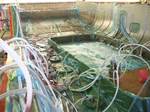Flow-front dynamics: Heat and vacuum hold
Three infusion experts talk about ways and means to avoid erratic flow fronts during resin infusion processes.
“Most shops heat the resin and leave the laminate stack and tool at ambient temperature,” observes Jay Carpenter, who teaches resin infusion at Abaris Training (Reno, Nev.). But he and other experts suggest there’s much more to the business of optimizing resin flow. Infusion consultant Phil Steggall (Bravolab, Jamestown, R.I.) points out that while heating the resin does reduce its viscosity, “as soon as the resin hits the colder surfaces, it will rise in viscosity and dramatically slow the flow.”
In his view, it’s better to heat the layup. “The temperature of the part is more important than that of the resin,” he contends. As it flows through the reinforcements, it is separated into myriad streams that “quickly come to equilibrium with the temperature of the laminate and tool under the bag.”
Carpenter notes, “We always do a heated vacuum soak before infusion.” This not only brings the laminate stack and tooling up to processing temperature, but it also draws out moisture from the stack. “I’m convinced most of our porosity problems are from the ambient moisture picked up by the laminate stack,” he explains.
Composites Consulting Group’s (CCG, Laholm, Sweden, and DeSoto, Texas) process specialist Dean Callander advises that this vacuum soak, if it is to remove air and other trapped volatiles, can’t be rushed. “Depending on part size, we encourage at least 45 minutes to an hour.”
Notably, the heat required to capture these benefits is modest. Carpenter says heating the dry stack to 90°F/32°C is sufficient, because with a good vacuum, the boiling point of water can be reduced to very near room temperature.“ But this is really only possible,” he warns, “if you have a good mold and a good pump.”
For those who are unconvinced, Carpenter suggests a test. Put a couple of loops in the vacuum line between the edge of the vacuum bag and the catch pot. “Over time,” he says, “you’ll see droplets of steam turn into condensation, just like in a condenser coil.”
Steggall has tested the effect of heating the laminate by maintaining one side at 65°F/18°C and the other at 95°F/35°C, infusing both with the same resin. “The cold side had more bubbles. It was a slower infusion with an erratic flow front, as the thicker resin came up against ‘roadblocks’ in the dry stack,” he reports. The heated side, in contrast, showed an almost straight-line flow front, with the heat causing bubbles to expand and come to the surface where they burst, so that the trapped air void content
was lower.
Steggall’s advice is to invest in a heated tool to preheat the dry laminate stack and consider how to heat the laminate on the B-side when using sandwich construction. “Core is an insulator and will effectively prevent the top surface from reaching the tool/laminate temperature,” he notes. “When you infuse, resin will chill down, here, and move more slowly. You do not want the asymmetrical flow front this will create.”
Related Content
-
Carbon fiber satellite arm reduces weight, simplifies assembly onto naval vessels
Satcom developer EM Solutions partnered with ACS Australia to replace an aluminum arm design with a 65% lighter, one-piece, corrosion-resistant carbon fiber/epoxy alternative.
-
Cannon introduces in-line resin degassing unit for infusion, RTM and pultrusion processes
Fully automatic system for processing large composite structural parts reduces overall degassing time in a single compact unit.
-
Mel Composites infusion strategy enables Sasga Yachts fiberglass hull designs
Mel’s ongoing partnership culminates in the development of the Menorquín 42 and Menorquín 54 motor yachts, as well as extension of Sasga’s capacity for 68-foot-length boats.






